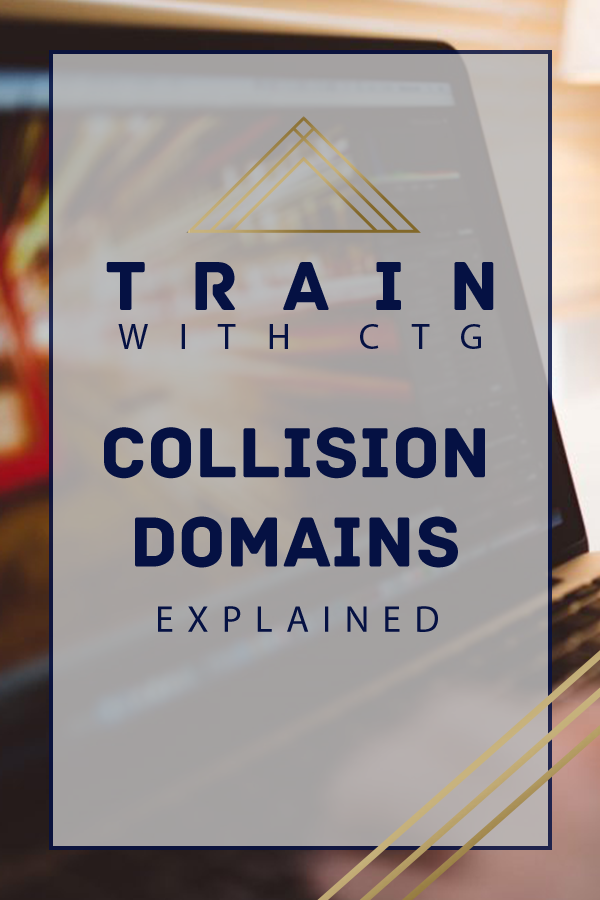As a CompTIA Network+ certified professional you are expected to understand network boundaries and the devices that define, or limit, those boundaries. These boundaries are known as domains. The first domain to learn about is a collision domain.
Let’s start with defining a collision. In networking, a collision occurs when two or more devices transmit simultaneously on a shared medium. The medium could be a wired medium, such as a cabled network, or a wireless RF channel. Any devices that could hear all transmissions from other devices are considered to be in the same collision domain. In other words, the devices have the potential to transmit at the same time on the shared medium.

Collision Domain Effects
So why are collisions a concern? The answer is that collisions reduce performance in a network. When a device is transmitting data and it detects another transmission on the medium while it is transmitting, that device must stop transmitting and try again. Having to stop and retry a transmission, perhaps multiple times, means it takes longer to get a message sent. The larger the collision domain the greater the probability that a collision will occur and slow the network performance.
Imagine a room full of students, all of whom wish to speak to the teacher. If the students just began speaking whenever they wished there would be multiple students speaking at the same time. They would be “colliding” with one another in the shared medium of the classroom. Multiple students speaking would make it hard to understand what any single student is saying. So, the students would have to stop and start speaking again. But then another student would talk over them and they would have to stop and start again. The class would not progress very well if this were the case.
As you know, there are rules in a classroom. If a student wants to speak they raise their hand. The teacher calls on that student and they can speak without interruption. The class proceeds in an orderly manner. In networking, there are also rules that help reduce collisions. For wired networks using Ethernet, the CSMA/CD (Carrier Sense Multiple Access with Collision Detection) is used. A wireless LAN would use the CSMA/CA (Carrier Sense Multiple Access with Collision Avoidance) protocol. I will discuss these protocols in later posts.
Hardware and Collision Domains
Since collisions are enabled by shared media, any hardware that creates shared media enables collisions. In the earliest days of Ethernet LANs were created with coaxial cables using the 10Base5 and 10Base2 standards. Each of the devices connected to the coaxial cable is in a single collision domain. With the release of the 10BaseT Ethernet standard, hubs were used to connect devices to form LANs. A hub is a multiport repeater: any signal transmitted by a device is repeated out all connected ports on the hub. Thus, the devices “share” the media of the hub and could collide with one another. This creates a single collision domain, regardless of how many ports the hub has. When multiple hubs are connected to each other to form larger LANs, it is still one large collision domain. Remember, a hub is a repeater. To illustrate, consider a hub with devices A, B, C, and D connected. When device A sends a transmission to device D, each of the connected devices will see that transmission. And any of them could send a transmission at that moment and cause a collision.
If collisions are bad and large numbers of devices in the collision domain impact performance, what can be done to reduce collision? The answer is more hardware. Specifically, the Ethernet switch. In brief, a switch receives a transmission from a device and only sends it out the port where the destination device is located. The switch does not send the transmission out all ports. When device A sends a transmission to device D, the switch only sends that transmission out the specific port where device D is located. Devices B and C never see it. Therefore, device B could send a frame to device C at the same time and the switch would not allow a collision to occur. Thus, each port of the switch is an independent collision domain. If devices are connected to their own dedicated switch ports, then collisions do not occur. A switch limits, or bounds, collision domains. There is one type of transmission that a switch will send to all ports. That is a broadcast. I will talk more about broadcasts and broadcast domains in a future post.
All modern LANs are based on switches. Hubs are rarely seen today. But the Network+ certified technician is expected to know the hardware that creates and limits collision domains.
Want to know more about topics found on the Network+ exam? Visit my website at www.trainwithctg.com. Sign up for our newsletter to get the latest information.